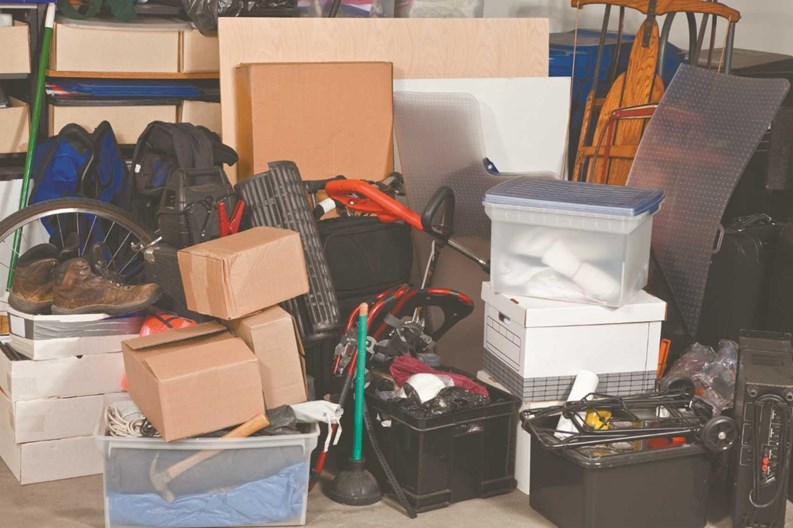It’s the age-old question for apartment dwellers living in cramped spaces: where do you store all of your possessions? If you live in a New York City co-op or condo, most buildings have a solution: sizeable storage units at the ready that you can rent out.
No one wants to give up livable space for storage closets, so creative alternatives are necessary to maximize usable dwelling areas while at the same time providing storage that's safe, clean and convenient for all residents. The placement of these areas can range from basements to in-unit facilities; it's up to residents and boards to decide which kind is right for their particular building.
The most common solution is using the building’s basement more effectively, states Jamie Barnard, owner of Giant Industrial Installations Inc. in College Point and a representative for national distributor WireCrafters. After all, he explains, “they turn an unused, disorganized and cluttered basement storage room into a moneymaker for the co-op or condo. Tenant storage is one of the highest revenue producers per square foot in the building.”
Not Your Average Storage Unit
And speaking of revenue production, not many can top One57, an ultra-luxury condominium under construction on West 57th Street that plans to ask $200,000 for some of its coveted basement storage lockers. The low-end units, according to the building’s offering plan, are priced at $110,000 each.
Now One57 is not your normal building, with high end amenities such as a private dining room, a theater screening and performance room, an arts and crafts room, a library/lounge and game room, and a private fitness center and yoga studio. So it’s storage amenity might just be the Rolls-Royce of comparable locker units.
For most buildings, the most common locker size is around 4’ x 4’ x 8’, but a building might go smaller to keep material cost and monthly fees low. Most buildings offer owners just one size to limit the administrative hassle, says Barnard. “We have done it every which way but the more popular way seems to be to give everyone the same size. If someone wants a bigger space, they take two or three small ones.”
While prices vary according to materials, a safe figure to use in calculating the build-out cost of the storage room, including painting and lighting, is $1,000 per 4’ x 4’ x 8’ locker, though more extravagant rooms can cost as much as $2,500 per locker.
Planning the Storage Room
The first step, says Josh Goldman, president of the Long Island City-based Bargold Storage Systems, is for an owner or the board deciding they want to install storage space in their building or they have a particular space in mind that they want to convert. Next, a company representative would contact them to do a survey and plan the space and determine how many lockers can be installed. The number of lockers to install is calculated based on variables such as the dimensions of the room and the projected demand for storage space among residents.
Goldman says almost all of the storage they do is indoors, because outdoor storage has proven to be less feasible and unsuccessful. Additionally, you can’t put storage units in spaces like garages because state law says they can’t be in an area where you are parking cars.
Fees, he says, are determined by a base size in the building. For example, a typical storage unit could be $50 a month in Queens, regardless of whether the storage size was 6-x-6, 4-x-6 or 3-x-3, he adds. “If there’s not a lot of space, we’ll build small, and if there’s an ample amount of space, we’ll build with larger units. Whatever the base size unit is for that building will be what we typically call our base rent in that area. It’s the base size in that building that determines the price.”
There is no maximum or minimum either, he says. Bargold has installed in as few as two units to as many as a 1,000-unit complex.
Barnard explains that a building survey will usually determine the interest among residents and that becomes the guide for how many units to install. Rental rates for storage lockers, as with most fees on services to shareholders or association members, are set with an eye to balancing profit with providing an amenity. “Some buildings want to provide the amenity and keep the cost down,” observes Barnard. “They look at it as increasing values. The more amenities you have the higher the property values.”
Whatever fees are set, both Goldman and Barnard estimate that they are bound to beat commercial storage operators, which in Manhattan tend to charge up to $195 a month for a 4’ x 4’ x 8’ locker, depending on the remoteness of the location—somewhat less outside the city. Co-ops and condos in Manhattan typically charge their residents around $65 a month for the same size, about 50 cents a square foot, and about $50 in the boroughs. The charge is usually added to the owner’s monthly maintenance statement. The charge for half-size units is typically around $30 a month.
To Rent or to Own
There are two distinct approaches to installing and maintaining a storage facility: outsource the entire operation to an outside vendor, which collects rent directly from the residents and remits a percentage to the co-op or condo, or install and manage the facility yourself.
“We remit 25% from day one in everything we collect in terms of rent,” says Goldman. “If we have something that’s rented for $50 and if it’s rented, and if the person pays, you’ll get $12.50 per month while that unit is being rented.”
“We put in state-of-the-art equipment, paint and light the room and we remit 25% of the rent we collect to the building.”
The company does the installation, lighting, security, and also, “we provide maintenance from day one through the end of the agreement,” he says, and that includes painting the room, painting the floors, wiping down, dusting, vacuuming, and more.
A maintenance agreement covers cleaning up things like water leaks or ridding the area of mice and other vermin that might be present in a damp, dingy basement. “We have an exterminator on retainer. If we get a complaint we take care of it immediately. Usually it’s not an issue, usually it’s taken care of after one or two visits.”
If there’s a water leak, they do an investigation to determine where the water is coming from and then coordinate with the building maintenance staff to get the issue resolved, he says. If there’s damage, the surface is repaired.
Solid Steel or Wire Cages
While Bargold provides solid steel custom-built containers, Giant, WireCrafters, SpaceGuard and other providers offer wire mesh storage lockers. Barnard claims that wire is cheaper because units share common walls, while solid metal containers are self-contained—closed all around.
And, according to Eddie Murphy, president of national distributor SpaceGuard Products, “wire mesh makes it easier to manage what people are storing, to make sure they are not storing, say, combustible materials inside their units. It also allows fire suppressant systems to operate unimpaired.” Wire mesh though also allows everyone to see what is being stored.
For those that just don’t have the room, more portable storage is available, according to Gary Flyer, owner of Urbins in Riverdale. “We offer a unique solution for storage in co-op garages as well as interior areas where there may not be enough space for storage rooms,” says Flyer. “We offer a unique wall hung metal storage cabinet that is 48-inches wide by 36-inches high by 30-inches deep.”
So, if a building has a garage or an area too small for walk-in storage rooms, the building can still offer storage with these storage units, as they are wall-mounted and use unused wall space. Items that Flyer recommends storing this way include golf clubs, baby furniture, and tires.
Goldman unequivocally stands by his product, noting that his units are made of the strongest materials on the market. “I always say our units will outlast the cockroaches, because if things are falling apart in the building, the last thing that will fall apart are our storage units. They’re put together like an erector set, they’re custom-built for that space and they are overbuilt for the area.”
A solid unit is protected from the elements, he says. “I would definitely like to store in a solid unit where I knew my contents were somewhat protected from the environment.”
A Bicycle Built for Two?
Another add-on, says Goldman, that is trending now, is bike storage. They now will install bike rooms as part of a building’s 10-year contract for free, and it becomes the building’s space immediately. So they can make extra income on their bikes, he says.
Goldman’s company is working with Rudy Rack, a Wisconsin-based distributor, to put in the bike rooms, according to Staci Galloway, Rudy Rack vice president.
“You have a lot of people in high-end buildings, they can pay $10,000 for a bike these days, so they don’t want to put it in a storage facility, leaning it against the wall, or just sticking it somewhere that it could get damaged. It’s an investment. So having proper racks that hold the bike properly and don’t do any damage to it, and don’t risk getting it scratched, or trashing the rims by hanging it on a hook, can be key for those type of buildings.”
For buildings where space is an issue, she says, high-density racks might be a solution. “It’s really going to fit a ton of bikes in a small amount of space. Each bike room is really dependent on different goals, and different setups.”
Galloway says usually the bike racks are a one-time purchase, and it’s not a lease or rental arrangement like typical storage would be. Bikes can be individually secured and locked to the rack itself, she says.
Put It in Writing
Management experts advise residents to have an iron-clad lease agreement and also to verify that their homeowner’s policy covers damage in storage lockers. Some policies treat a locker with the owner’s possessions in the same building in which they reside as if it were a closet within their apartment, while others want an extra premium for the coverage of stored possessions.
Debra A. Estock is managing editor of The Cooperator. Freelance writer Steven Cutler contributed to this article.







Leave a Comment